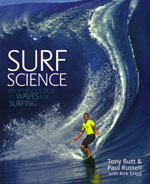Book Report: Surf Science--An Introduction to Waves for Surfing (10/04) I was stoked to be offered a complimentary surf science book by University of Hawaii Press. As always, I said I'd be happy to review it, with the understanding that I'd be "brutally honest." Since it was published by UH Press and had Rick Grigg as a contributor, I kind of assumed that this would be a more Hawaii-centric publication. However, principle authors Butt and Russell are both from the UK, so the writing and photography, although intended for worldwide application, was slanted slightly towards the European surfing region (it is being republished in Hawaii with some extensive edits provided by Grigg). Also, some spelling and terminology is different from what my narrow, US-centric mind is accustomed to (such as "centre" and "anticlockwise"). Minor stuff, but just not quite what I expected. It turns out the book is an excellent resource for surfers who want a simple understanding of the how's and why's of wave creation and surf conditions. The presentation is fairly nontechnical, with basic concepts favored over mathematical equations, and references are for folks who want more. (Being a nerdy engineer, I personally thirsted for more equations.) There were several things that intrigued me. The large-scale, worldwide wind/weather patterns were explained exceptionally well by first using a simplified model then adding on layers of complexity. I did not realize that the Indian Ocean has the most consistent wave energy production in the world (no wonder Indo is such a great surf region). Group propagation was fascinating, with the last wave in a swell train constantly moving from the back to the front of the group. There were great explanations of how bathymetry (ocean bottom contour) and refraction helps characterize waves. And the zone-by-zone wave climates may be quite useful for surf travelers. However, some items begged further detail. More info on underwater orbitals could help surfers understand how waves jack in size and may help in the art of duckdiving. There should have been URL references to all the online surf forecasting tools. And would have loved to see some examples of how swells from multiple directions interact. Overall, it's a good read. If you want to learn how waves are created to help maximize your surf session wave quality, check this book out. One more nit before we go: On the title page, goofyfooter Derek Ho is erroneously going frontside on a right (with board logos inverted). The image was probably flipped for layout purposes. Would probably be passed over by most people, but not by "brutally honest" surf literature reviewers. ;-)
More Review/Links |
 Surf Science--An Introduction to Waves for Surfing by Tony Butt & Paul Russell with Rick Grigg (2004).
Surf Science--An Introduction to Waves for Surfing by Tony Butt & Paul Russell with Rick Grigg (2004).